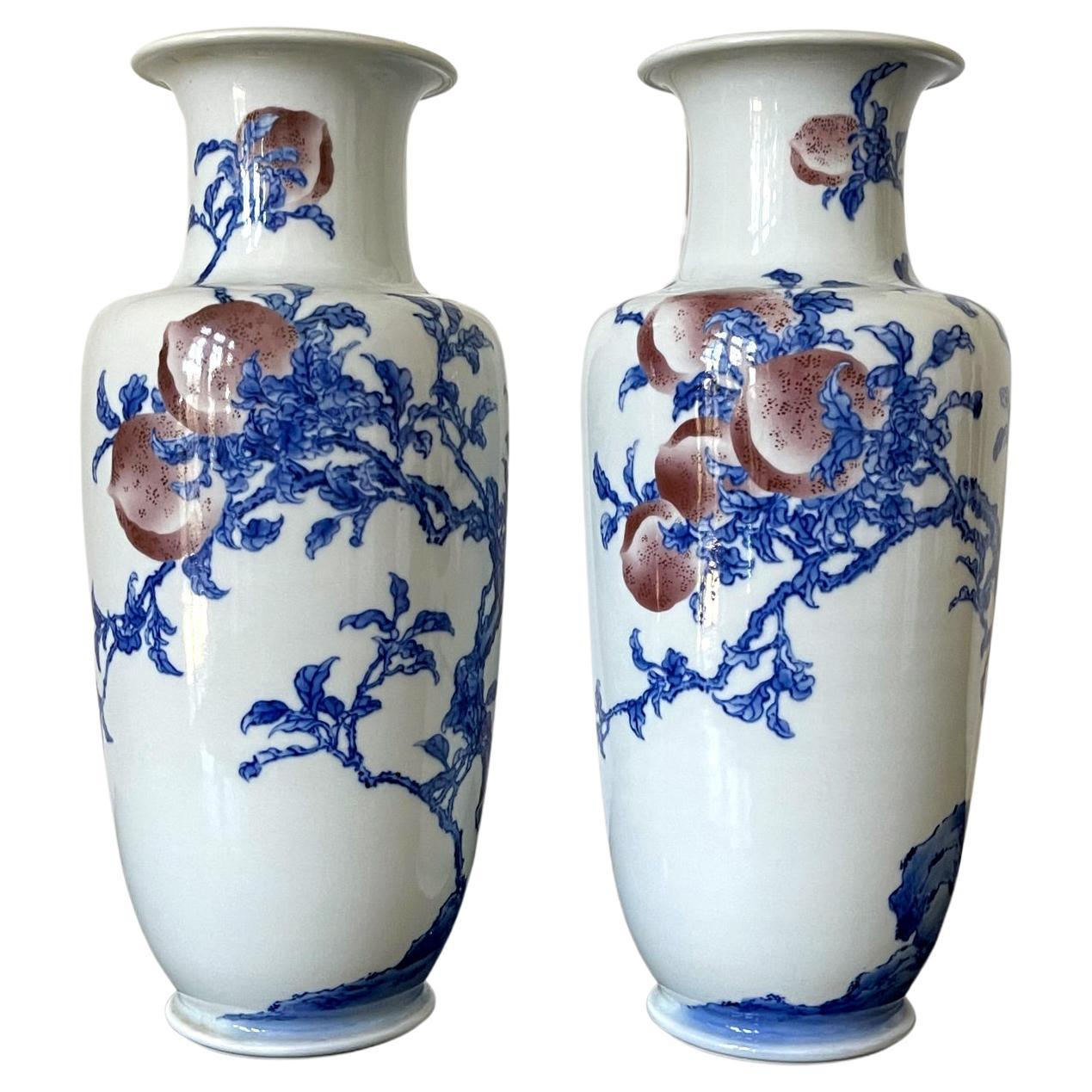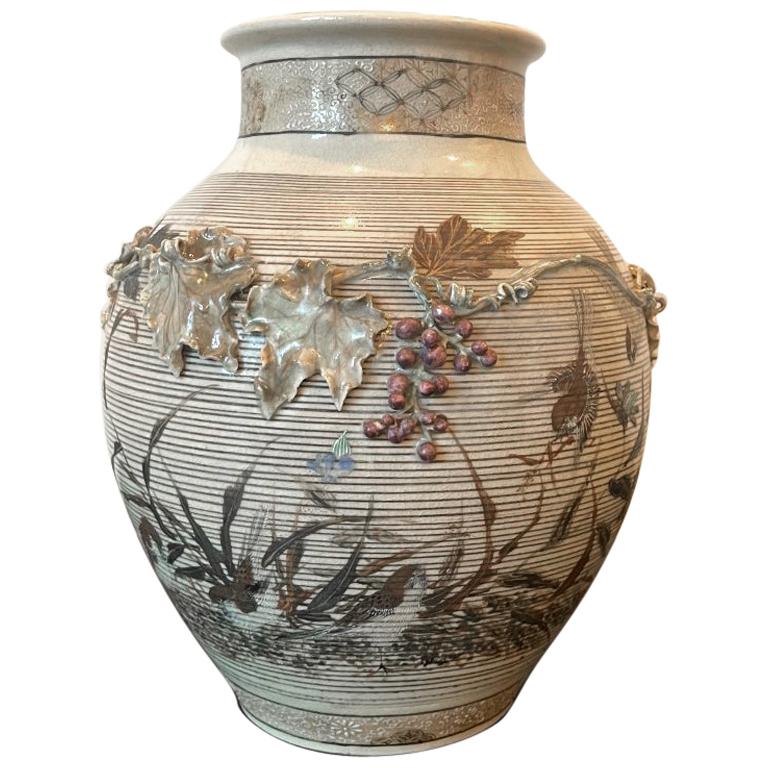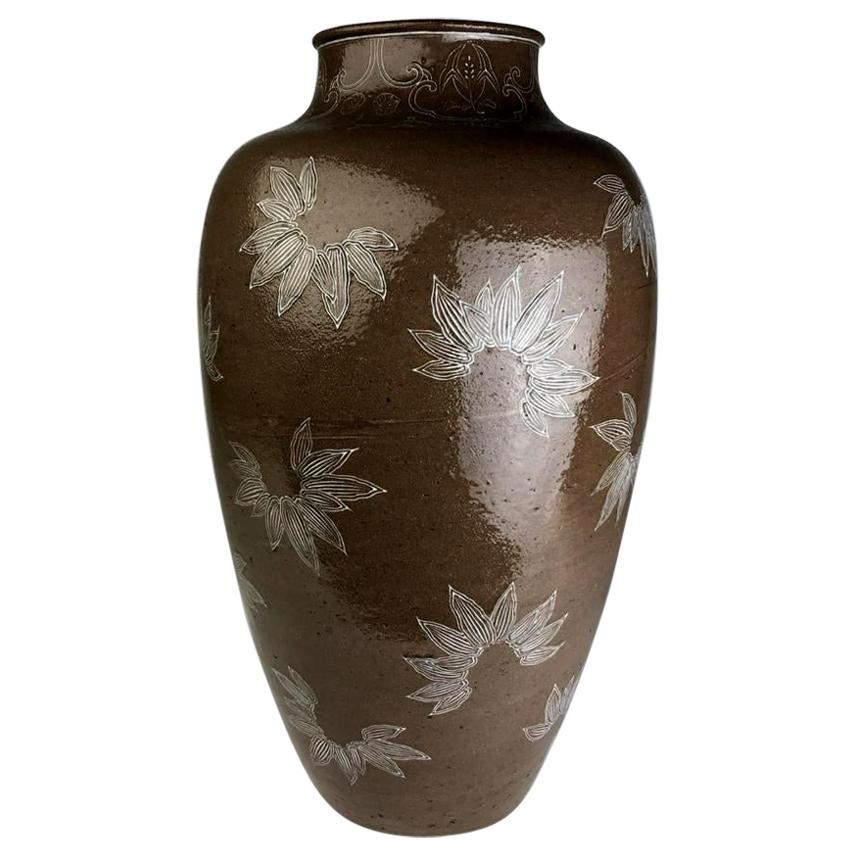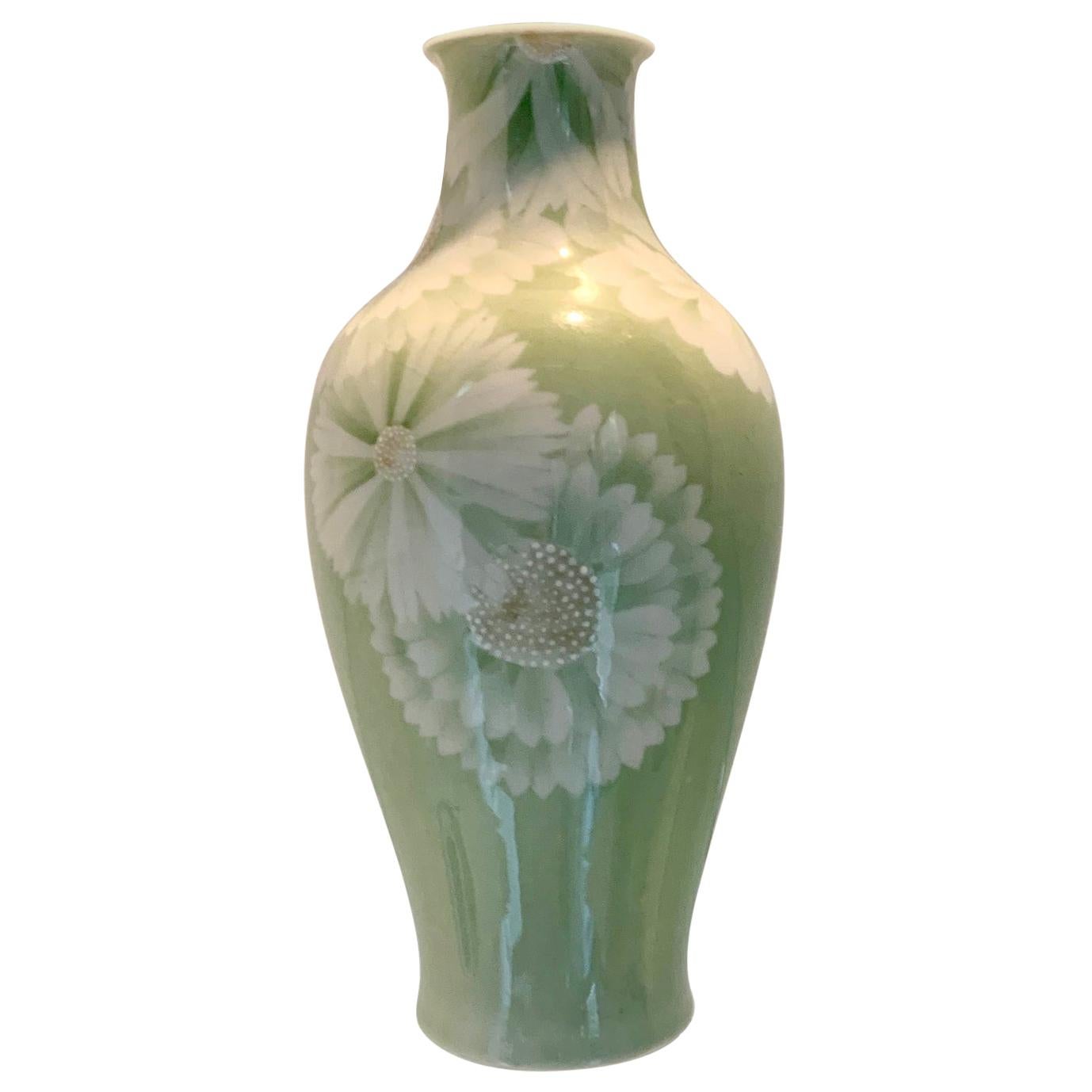Items Similar to Rare Pair of Early Period Makuzu Kozan Takauki High-Relief Vases
Want more images or videos?
Request additional images or videos from the seller
1 of 21
Rare Pair of Early Period Makuzu Kozan Takauki High-Relief Vases
About the Item
A stunning pair of ceramic vases with gilt, paint and high-relief decoration by imperial artist Makuzu Kozan (1842-1916, also known as Miyagawa Kozan) circa 1876-81 (late Meiji period). These vases belong to early period (1876-1881) of Kozan's repertoire, during which time the high relief sculpturing (known as Takauki ware) was used as a distinguished technique on top of the traditional gilt and paint ornaments of satsuma ware. Due to the relatively limited production and the fragile nature of these wares, not a large quantity of the examples remained in the first place, not mentioning a fine matching signed pair in such impressive sizes.
Not only a rarity, this pair of vases is also superb in workmanship, thus the fine example of the work from that short and unique period of the artist's career before he switched to the underglaze period. In a conceptually mirrored fashion, the surface is richly decorated with flying cranes among large lotus leaves and flower, like an idyllic aqua scenery of pure poetry on a circular scroll. The high-relief appliques were rendered and composed in realistic fashion but with a dramatic touch. They are literally about to break the surface free, alive and in motion. The dark colors of the glaze were used to set a moody tone. The approach to create this type of ornamentations is more akin to sculpturing an ink painting in three-dimension than ceramic making. It is not hard to imagine the demand of both the artistry and the technique.
Both vases were signed as "Makuzu Kozan Kiln" and each further with another name and seal, which are most likely the individual artist involved in the making process. Similar signatures can be seen in the reference book below.
For similarly Takauki vases, see Miyagawa Kozan Makuzu Ware (Japanese Edition) page 30-73.
Retrospective Makuzu Kozan Miyagawa Collection Book: 46-148; for the same artist signature see the example on page 52, 64, 68, 70.
- Creator:Makuzu Kozan (Artist)
- Dimensions:Height: 15 in (38.1 cm)Diameter: 8.5 in (21.59 cm)
- Sold As:Set of 2
- Style:Japonisme (Of the Period)
- Materials and Techniques:
- Place of Origin:
- Period:
- Date of Manufacture:1876-1881
- Condition:Wear consistent with age and use. Fine intact condition, minor gilt loss around the neck. High-relief applique are well preserved, with possible minute chips on some free edges, hard to tell due to the design. Black night indicates small scattered enemal paint touchup.
- Seller Location:Atlanta, GA
- Reference Number:1stDibs: LU945027354332
About the Seller
5.0
Platinum Seller
These expertly vetted sellers are 1stDibs' most experienced sellers and are rated highest by our customers.
Established in 2006
1stDibs seller since 2010
479 sales on 1stDibs
Typical response time: <1 hour
- ShippingRetrieving quote...Ships From: Atlanta, GA
- Return PolicyA return for this item may be initiated within 2 days of delivery.
More From This SellerView All
- Pair of Rare Porcelain Commemorative Vases by Makuzu Kozan Meiji PeriodBy Makuzu KozanLocated in Atlanta, GAA pair of porcelain vases in classic form, decorated with underglaze blue and copper red painting by Imperial potter Makuzu Kozan. Also known as Miyagawa Kozan (1842–1916), Makuzu was one of the most established and collected ceramist known to the west from Meiji Period. The vases are in a classic Chinese form called "Bang Chu Ping" (grain-mallet vase...Category
Vintage 1910s Japanese Japonisme Ceramics
MaterialsCeramic
- Japanese Porcelain Vase Makuzu Kozan Meiji PeriodBy Makuzu KozanLocated in Atlanta, GAA striking blue and white vase from the studio of Japanese Potter Makuzu Kozan, also known as Miyagawa Kozan (1842–1916), one of the most established and collected ceramist from Meiji Period. Born as Miyagawa Toranosuke, Kozan established his pottery studio in Yokohama circa 1870s and later became one of the appointed artists to the Japanese Imperial household. His work was exhibited in many international fairs that the Meiji government participated at the turn of the century and won many grand prizes. Of a relatively large size, this vase is decorated with underglaze cobalt blue using the novel technique developed by Kozan called Fuki-e (the blow painting). As a result, the bamboos appear took on a three-dimensional quality as if appearing in a mist. Known as one of the most creative ceramists, circa 1887, Kozan started experimenting with new chemical colors from the West in the format of his porcelain glaze. New colors allowed him to create underglaze design that appeared bright, smooth and glossy. He even invented his own receipt of cobalt blue to achieve a much brighter yet softer shade, as evident on this vase. To create landscape that is realistic and dimensional, more common in the western paintings, he was inspired by the native Japanese ink painting technique developed around 1900 by Yokoyama Taikan...Category
Antique Early 1900s Japanese Japonisme Ceramics
MaterialsCeramic
- Japanese Porcelain Vase with Relief Surface Makuzu KozanBy Makuzu KozanLocated in Atlanta, GAA rare porcelain vase by Makuzu Kozan (1842-1916) circa 1870-81 (late Meiji period). The vase is dated to the earlier work from Kozan's studio during his early period (Takauki-ware p...Category
Antique Late 19th Century Japanese Japonisme Ceramics
MaterialsCeramic
- Rare Large Vase with White Slip Inlay Makuzu Kozan Meiji PeriodBy Makuzu KozanLocated in Atlanta, GAA impressively large and unusual stoneware vase in an urn shape from the studio of Japanese Potter Makuzu Kozan, also known as Miyagawa Kozan (1842–1916), one of the most established and collected ceramist from Meiji Period. Born as Miyagawa Toranosuke, Kozan established his pottery studio in Yokohama circa 1870s and later became one of the appointed artist to the Japanese Imperial household. His work was exhibited in many international fairs that the Meiji government participated at the turn of the century and won many grand prizes. This vase is dated to the end of Makuzu's life circa 1910-1916 based on similar work created around that time. After achieving domestic and international fame, Makuzu retired and handed the business to his son Hanzan in 1912. He dedicated his time to other selected projects that were more in tune with Japanese sensibility than export aesthetic. He made a group of stoneware pottery pieces inspired by Edo master like Ninsei and Kenzan as well as his own poetic creation. This piece is attributed to that period. Standing of an impressive size, this vase is more like an urn, made with stoneware instead of porcelain. It was coated with a brown iron glaze with a slight translucent quality. Underglaze whit slips were used to draw low relief decoration of bamboo leaves that sparsely scatter on the surface. Slightly more elaborate scrolling vines and autumn flowers circles under the mouth rim. Same white slip inlay was used to sign the vase under the base. The whole effect of the piece is unusual. With its dark glaze in contrast with the sparse white decoration that is more abstract and geometric than realistic, it appears almost modern with an Art Deco flavor. For stoneware urn and vase in the similar genre by Makuzu Kozan: see figure 113 on page 182 of "Sekai ni Aisa Reta ya Kimono" MIYAGAWA KOZAN MAKUZU...Category
Vintage 1910s Japanese Japonisme Ceramics
MaterialsCeramic
- Rare and Large Japanese Porcelain Vase Makuzu KozanBy Makuzu KozanLocated in Atlanta, GAA striking blue and white vase from the studio of Japanese Potter Makuzu Kozan, also known as Miyagawa Kozan (1842–1916), one of the most established and collected ceramist from Meiji Period. Born as Miyagawa Toranosuke, Kozan established his pottery studio in Yokohama around 1870s and later became one of the appointed artist to the Japanese Imperial household. His work was exhibited in many international fairs that the Meiji government participated at the turn of the century and won many grand prizes. With an impressively large size, this vase was likely made and reserved as a presentation piece for one of the many expositions the studio participated in the early 20th century. It was decorated with underglaze cobalt blue using the novel technique developed by Kozan called Fuki-e (the blow painting), in order to achieve the striking dimensional literary landscape known as "Mountain and Water". Being one of the most creative ceramists, Kozan started experimenting with new chemical colors from the West in the format of his porcelain glaze around 1880s. New colors allowed him to create underglaze designs that appeared bright, smooth and glossy. He even invented his own receipt of cobalt blue to achieve a much brighter yet softer shade, as evident on this vase. To create landscape that is realistic and dimensional, more common in the western paintings, he was inspired by the native Japanese ink painting technique developed around 1900 by Yokoyama Taikan...Category
Early 20th Century Japanese Japonisme Ceramics
MaterialsPorcelain
- Japanese Porcelain Vase Meiji Period Makuzu KozanBy Makuzu KozanLocated in Atlanta, GAA finely decorated and glazed Japanese porcelain vase by Makuzu Kozan (1842-1916) circa 1900s Meiji Period. The vase is of a classic bottle form with baluster body and short neck. It was decorated with underglaze white magnolia blossom on a pleasant celadon background. The stamens of the flower were artistically rendered in a low relief, giving the design a realistic appeal with the dimension. Miyagawa Kozan...Category
Early 20th Century Japanese Meiji Ceramics
MaterialsPorcelain
You May Also Like
- Medji Period High Relief Porcelain Celadon Vase, circa 1900Located in Miami, FLThis captivating Medji period (1868-1912) porcelain vase features a mesmerizing celadon glaze, with a subtle crackled texture. Exquisite details, meticulously hand-painted in vibrant...Category
Early 20th Century Japanese Meiji Vases
MaterialsPorcelain
- Pair of Early 20th Century 'Republic Period' Chinese Urn VasesLocated in North Miami, FLA pair of early 20th Century (Republic Period) Chinese urn vases created in the traditional cloisonne method. The miniature vases features brass metal forms with a classic baluster shape. The surface has been exquisitely hand decorated in colored enamel with cherry blossoms and flower patterns growing out of a turquoise rock formation. Both come with their original wooden display stands...Category
Early 20th Century Chinese Vases
MaterialsBrass
- Rare Set of 4 Meiji Period Imari Bottle Form VasesLocated in Lambertville, NJA rare set of four hand painted Japanese porcelain Imari bottle form vases. The vases of square tapering form with classic Imari iron red and cobalt blue ...Category
Antique 1880s Japanese Meiji Ceramics
MaterialsPorcelain
- A pair of large Meiji period Satsuma Rouleau vasesLocated in London, GBA pair of large Meiji period Satsuma Rouleau vases Japanese, Late 19th Century Height 54.5cm, diameter 24cm These beautiful Satsuma-ware vases were made ...Category
Antique Late 19th Century Japanese Meiji Ceramics
MaterialsEarthenware
- Makuzu Kozan II Signed and Stamped Japanese Ceramic Flower Pottery Bowl Pot VaseBy Makuzu Kozan IILocated in Studio City, CAA beautiful handmade handled bowl by well-known Japanese ceramic artist Makuzu Kozan II, son of Makuzu Kozan who was appointed artist to the Japanese Imperial household and was one o...Category
Vintage 1930s Japanese Showa Ceramics
MaterialsCeramic
- Pair of Japanese Meiji Period Imari Vases with Dragon HandlesLocated in New York, NYA Monumental pair of Japanese Meiji Period Imari vases with Dragon handles, Japanese Porcelain Studio Marks on Underside. Each is beautifully ...Category
Antique 1880s Japanese Meiji Ceramics
MaterialsPorcelain





